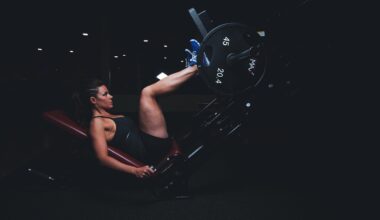Success Stories in Plyometric Training: What Worked
Plyometric training has garnered immense attention for its impressive results, especially among athletes. From sprinters to basketball players, many have shared remarkable transformations attributed to plyometric exercises. Increased explosiveness and speed are frequently reported benefits, but the stories behind these improvements are compelling. For instance, one college track athlete recounted how incorporating depth jumps significantly enhanced their vertical leap. With consistent training, they progressed from a 28-inch jump to an astounding 34 inches within a year. This success story exemplifies the physical potential that can be unlocked through targeted plyometric routines. Another athlete, primarily focusing on agility, described how jump squats and bounding drills reshaped their performance on the field. They recorded faster sprint times during competitive events, attributing this to their effective training regimen. Furthermore, numerous coaches have noted the value of integrating plyometrics into an athlete’s training program. These stimulating workouts lead to improved muscle coordination, better shock absorption, and ultimately greater athletic success. Regular plyometric workouts can uniquely contribute to an athlete’s performance enhancement and longevity in their chosen sport.
A standout success story from the realm of plyometric training is that of a young basketball player who dreamed of playing in college. Initially struggling with vertical leap, his coach integrated plyometric drills focused on jumping techniques and lower body strength. As a result, the young athlete diligently practiced exercises like box jumps and single-leg hops. Within a few short months, significant changes became apparent. He successfully increased his vertical leap by over seven inches, allowing him to reach for rebounds and finish dunking during crucial games. His hard work paid off, catching the attention of recruiters and leading to a full scholarship. Success stories like this demonstrate how consistency and commitment to plyometric training can result in transformative athletic performance. Another inspiring example is a soccer player who incorporated plyometric training to enhance her speed and agility. Through drills such as lateral bounds and squat jumps, her ability to change directions improved vastly. This allowed her to evade defenders more effectively, drastically enhancing her game. The transition emphasized how integrating plyometric movements can significantly affect athletic prowess in various sports.
In addition to individual athletes, countless teams have successfully adopted plyometric training to boost performance across the board. A notable example is a high school football team that implemented a plyometric program aiming to build strength and speed. Coaches in this program focused on various exercises such as box jumps and tuck jumps. The season brought impressive results, with many team members experiencing enhanced acceleration and explosiveness off the line. With remarkable coordination improvements, players saw notable increases in overall game performance. This transition dramatically reduced injuries thanks to increased muscle strength and tendon resiliency. Also, volleyball teams have found success by integrating plyometric training routines into their schedules. One example involved a college team that emphasized jump training to improve overall blocking and attacking speeds. Through a consistent regimen of plyometric drills, players experienced a rise in jumping ability, resulting in greater on-court dominance. The collaborative effort showcased the immense benefits that plyometrics can offer across various sports, as they foster teamwork while building strength, agility, and coordination among its members.
Community Impact of Plyometric Training
Beyond individual and team success stories, plyometric training has also positively influenced entire communities. Local sports clubs adopted these methods to promote athletic development among youth, fostering an environment focused on growth and empowerment. One community center initiated a summer program targeting young athletes, highlighting plyometric exercises to boost overall performance and confidence. Feedback from participants revealed extraordinary gains in not just physical capability but also in self-esteem and motivation. Success stories emerged as participants shared their newfound accomplishments in local competitions, showcasing improvements in speed, agility, and strength. Another inspiring initiative involved a mentorship program linking experienced athletes with younger members. This collaboration emphasized the importance of plyometric training in achieving athletic goals. Mentors shared their own success stories through plyometrics, demonstrating tangible results that motivated the youth. This interconnected approach nurtured growth within communities while furthering the positive impact of physical training in various sports. Encouraging young athletes to embrace plyometric training as a regular part of their regimen leads to future champions who continuously inspire those around them through their remarkable success stories.
Email newsletters from these youth sports programs consistently highlight achievements resulting from plyometric workouts. Parents and coaches eagerly share updates about the athletes’ performance boosts, showcasing how consistent training can yield substantial gains. It’s not uncommon to read about one young athlete increasing their sprint time by significant margins or improving their overall endurance, all attributed to a focused plyometric routine. Testimonials include stories of children combating previous challenges such as lack of confidence. By adopting plyometric exercises into their training, many have vastly improved self-worth and athleticism. Crafting a concrete foundation in sports also helps these children develop valuable life skills, such as discipline and teamwork, crucial for their future. Incorporating plyometric training into local athletic programs demonstrates the importance of adaptability and commitment to achieving desired results. As these young athletes inspire their peers, the positive feedback loop grows within the community. Therefore, plyometrics not only amplify athletic performance but also contribute to a thriving culture of support and achievement among future generations, resulting in an even more significant impact on sports.
Many people recognize successful collegiate programs that embrace plyometric training. A prime example involves a respected track and field program known for its rigorous training methods. Athletes regularly participated in plyometric drills as part of their conditioning routine to elevate performance levels. The combination of consistent strength training and plyometric exercises resulted in a remarkable track record of top finishes at state competitions. Some athletes, motivated by previous success stories, have set their sights on breaking records. This synergy enhances competition and morale, as success. On the other hand, inspiring stories from professional athletes showcase just how effective plyometric training can be. One renowned Olympic sprinter attributes much of their success to plyometric-focused workouts during off seasons. Functional movements interspersed with speed and agility drills foster tremendous improvements in explosiveness over time. Their athletic prowess demonstrates the strength of plyometrics in achieving elite status. Coaches and trainers have focused on unraveling the science behind these training methods. By consistently validating, revisiting, and improving plyometric drills, they safeguard their athletes’ success in both competitive environments and throughout their careers.
The Future of Plyometric Training
Looking ahead, the evolution of plyometric training remains exciting. As technology continues to shape sports performance, various innovations have emerged that enhance the effectiveness of plyometric workshops. Coaches actively explore novel equipment and training platforms to deliver tailored experiences to athletes. New methods such as wearable technology can track progress in real-time, allowing for immediate adjustments and tracking of performance improvements over time. Personalized training regimens that center on individual strengths and weaknesses make plyometrics even more engaging and effective. Enthusiasm for plyometric training continues to grow, inspiring new generations of athletes to incorporate these dynamic exercises. Moreover, workshops and seminars dedicated to plyometric training have become increasingly popular. Experts share their insights and practical knowledge to empower coaches, athletes, and trainers. These gatherings foster collaboration while nurturing a wealth of information concerning optimal techniques and safety measures. Ultimately, this exchange of knowledge will facilitate developing innovative plyometric strategies. So, participants will see continued success in maximizing their athletic potential while minimizing risks associated with injury. As the future unfolds, plyometric training remains an essential tool for the ongoing pursuit of excellence in sports.


